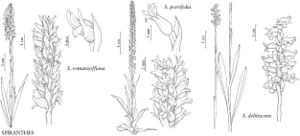Difference between revisions of "Spiranthes porrifolia"
Gen. Sp. Orchid. Pl., 467. 1840.
FNA>Volume Importer |
imported>Volume Importer |
||
| (5 intermediate revisions by 2 users not shown) | |||
| Line 6: | Line 6: | ||
|place=467. 1840 | |place=467. 1840 | ||
|year=1840 | |year=1840 | ||
| + | }} | ||
| + | |special_status={{Treatment/ID/Special_status | ||
| + | |code=F | ||
| + | |label=Illustrated | ||
| + | }}{{Treatment/ID/Special_status | ||
| + | |code=E | ||
| + | |label=Endemic | ||
}} | }} | ||
|basionyms= | |basionyms= | ||
| Line 11: | Line 18: | ||
|name=Spiranthes romanzoffiana var. porrifolia | |name=Spiranthes romanzoffiana var. porrifolia | ||
|authority=(Lindley) Ames & Correll | |authority=(Lindley) Ames & Correll | ||
| + | |rank=variety | ||
}} | }} | ||
|hierarchy=Orchidaceae;Orchidaceae subfam. Orchidoideae;Orchidaceae tribe Cranichideae;Orchidaceae (tribe Cranichideae) subtribe Spiranthinae;Spiranthes;Spiranthes porrifolia | |hierarchy=Orchidaceae;Orchidaceae subfam. Orchidoideae;Orchidaceae tribe Cranichideae;Orchidaceae (tribe Cranichideae) subtribe Spiranthinae;Spiranthes;Spiranthes porrifolia | ||
| Line 34: | Line 42: | ||
-->{{#Taxon: | -->{{#Taxon: | ||
name=Spiranthes porrifolia | name=Spiranthes porrifolia | ||
| − | |||
|authority=Lindley | |authority=Lindley | ||
|rank=species | |rank=species | ||
| Line 48: | Line 55: | ||
|publication title=Gen. Sp. Orchid. Pl., | |publication title=Gen. Sp. Orchid. Pl., | ||
|publication year=1840 | |publication year=1840 | ||
| − | |special status= | + | |special status=Illustrated;Endemic |
| − | |source xml=https:// | + | |source xml=https://bitbucket.org/aafc-mbb/fna-data-curation/src/2e0870ddd59836b60bcf96646a41e87ea5a5943a/coarse_grained_fna_xml/V26/V26_1108.xml |
|subfamily=Orchidaceae subfam. Orchidoideae | |subfamily=Orchidaceae subfam. Orchidoideae | ||
|tribe=Orchidaceae tribe Cranichideae | |tribe=Orchidaceae tribe Cranichideae | ||
Latest revision as of 21:11, 5 November 2020
Plants 15–60 cm. Roots few–several, spreading to descending, tuberous, mostly to 1 cm diam. Leaves persisting through anthesis or fugaceous, basal, often on proximal portion of stem, ascending, linear to linear-lanceolate, linear-oblanceolate, oblanceolate or elliptic, to 34 × 3.5 cm. Spikes usually very tightly spiraled, rarely loosely spiraled, usually 3 flowers per cycle of spiral; rachis glabrous to sparsely pubescent, trichomes less (usually much less) than 0.18 mm, capitate glands often sessile. Flowers ascending, creamy to markedly yellowish, slenderly tubular; sepals connate at base, 4.6–11 mm, apex reflexed-spreading; petals linear-lanceolate to linear-oblanceolate, apex reflexed-spreading, obtuse to subacute or subemarginate; lip lance-ovate to lanceolate, 4–9.5 × 1.9–4.3 mm, apex recurved less than to scarcely more than apices of sepals and petals, only slightly or not at all dilated, with subapical dense cushion of peg-shaped trichomes on adaxial surface; veins few to several, branches wide-spreading or often parallel; viscidia linear to linear-elliptic; ovary mostly 2–7.5 mm. Seeds monoembryonic. 2n = 44 [66].
Phenology: Flowering May–Aug.
Habitat: Moist to wet riparian meadows, stream banks, marshes, fens, seeping banks
Elevation: 100–2600 m
Distribution

Calif., Idaho, Nev., Oreg., Wash.
Discussion
Selected References
None.
